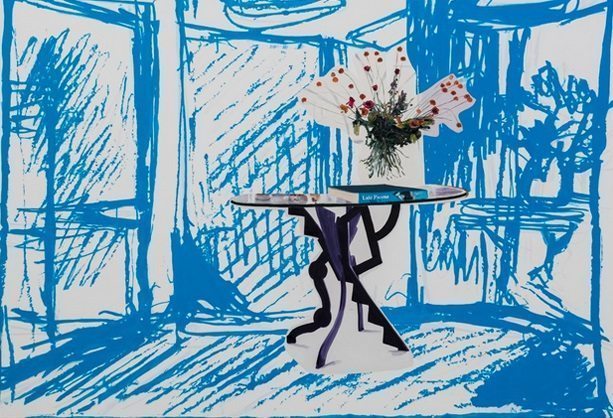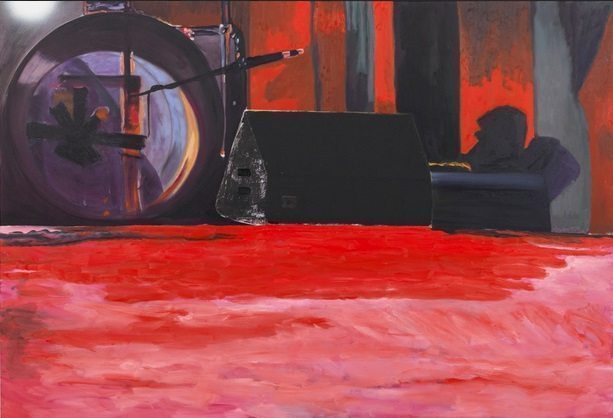[dropcap style=”font-size:100px; color:#992211;”]I[/dropcap]n ‘Double Portrait (Camden Town)’ London-based artist, Dexter Dalwood‘s black paint resembles a giant Rorschach inkblot test, as if literally asking, ”what do you see?”.
Indeed, there is a palpable sense of mystique running through the eleven representations of the capital city which make up the artist’s current ‘London Paintings’ exhibition for Simon Lee Gallery. [quote]every scene depicted – whether
intimate or formal – has
indelible human presence[/quote]Dalwood uses curious motifs, idiosyncratic painterly touches and references to artworks of the past to depict a unique vision of London; a city as scarred by its secrets as it is shaped by lore.
As with Dalwood’s 2010 Turner Prize-nominated series, the absence of human figures in all of these paintings is jarring, as every scene depicted – whether intimate or formal – has indelible human presence. However, whereas his previous work featured imagined interiors and locations acting as memorials to real people, here it is the narratives which are imagined. There is also a sense that the artist is hinting at more personal events, too. Each work expresses a certain impenetrability; a significance which lies just outside the realms of the viewer’s comprehension.
In his representation of the Thames, Dalwood crosses Hockney with Monet, positioning the former artist’s sun-lit LA swimming pools alongside the murky still of the Thames on a foggy night; the bright lights of Southbank glaring out of the gloom above. It’s a striking juxtaposition but also instructive in our reading of the entire series; Dalwood seems to be exploring the relationship between place and time and its effect on our psyche.
‘Old Bailey’ features the entrance to the famous court and has the look of an over-exposed photograph, with large areas of the building left undefined. The red pillars and curious ‘pop art’ flame lashing out from the left of the composition speak of a hellish location and bring to mind the Great Fire of London, which actually destroyed parts of the building in 1666. It works equally well as a representation of a place feared but never visited, or a place whose walls are remembered only too well; vivid memory burned into the mind. The painting evoked in me a similar sense of dread as Francis Bacon’s ‘Study after Velázquez’s Portrait of Pope Innocent X’ and the failing vibrancy of that work is also evident here, expressing an existential rage.
And there is this general sense of unease about the whole collection. ‘Powis Square’ is a compositionally bold painting, featuring vast empty spaces disrupted by three distinct components. An oddly angled rococo-style mirror looms at the top of a high-ceilinged room, watching over everything below; a small section of a fireplace occupies the bottom right corner, and a curiously unrecognisable object is partly revealed at the bottom of the work. Dalwood’s formation of these elements has them positioned at the edges of the canvas, as distant from each other as they can be. It is an austere and disorientating space and speaks of an unsettled, naive inhabitant.
The sleazy night scene of ‘Interior at Paddington’ plays like something out of a dark Lynchian dream-sequence which one doesn’t know whether to guiltily enjoy or wake from. This is the same dark and gloomy London as depicted in some of Walter Sickert’s early work. Also evident is Sickert’s technique of flattening three-dimensional space by emphasising the patterns of wallpaper and decoration. The red lamp is a menacing, unsettling presence rather like the plant in Lucian Freud’s 1951 work of the same name. The solid pink glow of the lamp is rendered in a way which makes it appear beamed in from an alternative reality. This lends the scene an almost supernatural energy.
I got a similar feeling looking at ‘Half Moon Street’. The plant and table are painted over the top of the background, hovering in their own bubble; the plant is without a vase. They share a setting but seem to exist in different moments. It speaks of the passing of time and the evolution of place. Something about the way the table is painted and the simple, everyday objects hint at Picasso and Braque’s synthetic cubism period (the spine of the book which sits on the table reads, ‘Late Picasso’), and the spatial and temporal concerns of that collaboration are quietly echoed here.
A time-related theme is also present in ‘Old Thames’. Here, Dalwood depicts a weary old boat sat on the dirty river. The silky finesse of the pattern which dances around the vessel is beautiful but betrays the dull colours and flat composition, which represent the unrelenting passage of time.
‘Roundhouse’ is a very different image. It seems to capture a single, specific moment in time and as such is charged with a certain electricity. The lush red brushstrokes across the middle of the canvas and bright light in the top left corner lend a sense of urgency and excitement which distinguishes the painting from the other, more contemplative works. A spontaneity is achieved by the odd point of view Dalwood presents us with, like that of an accidental photo from a camera dropped on the floor.
‘Heaven’ combines the impurity of ‘Interior at Paddington’ with the mystery of ‘Powis Square’. The garish colours and title of the work point to a nightclub scene, but unlike ‘Roundhouse’ it’s far from an enticing one. The noxious looking green mass lurking at the top of the canvas and strange, dirty white marks which pepper the large black section of the painting create a queasy atmosphere. The neon pink ‘EXIT’ sign says it all. ‘Heaven’ appears to be a sarcastic title; the scene speaks more of noise and pollution than fun and leisure.
With the eleven artworks which make up his ‘London Paintings’, Dexter Dalwood has created a distinctive portrait of his subject. Each painting displays a different facet to the personality but they are made unmistakably from the same genes. Dalwood’s London is rich and complex but also burdened by its own reputation; battered and bruised by the lives it carries through history.
London Paintings runs until 24th January 2015 at Simon Lee Gallery, London W1J
[button link=”http://www.simonleegallery.com/” newwindow=”yes”] Simon Lee Gallery[/button]






















